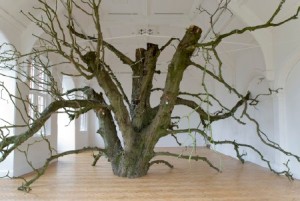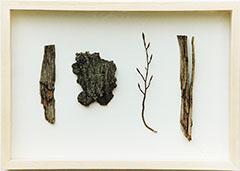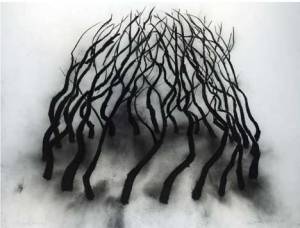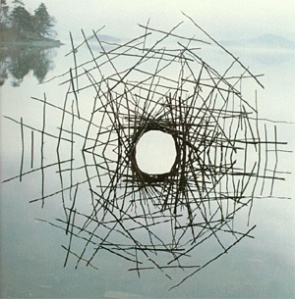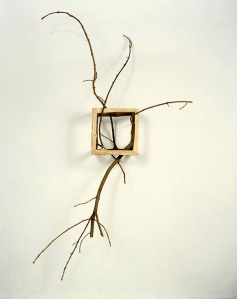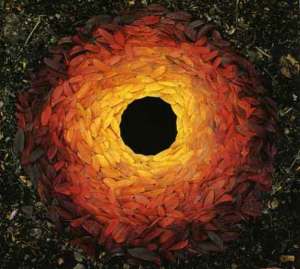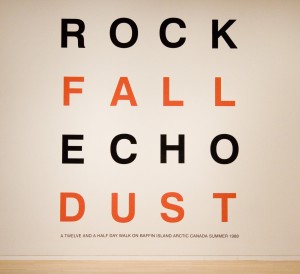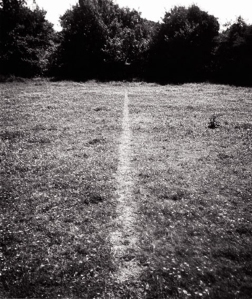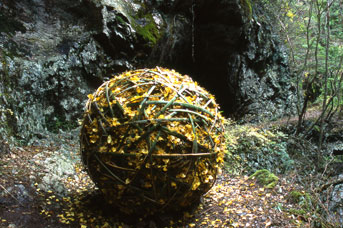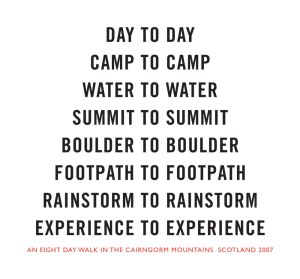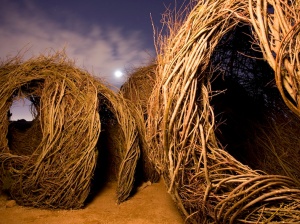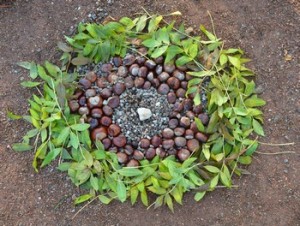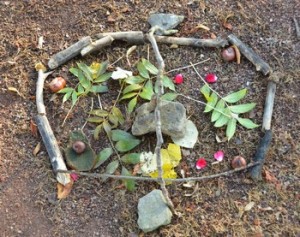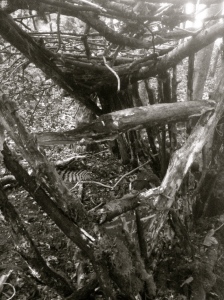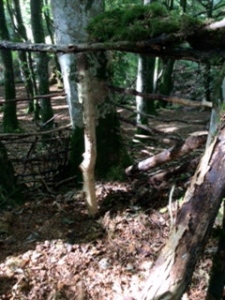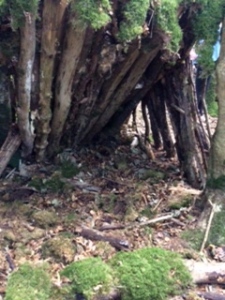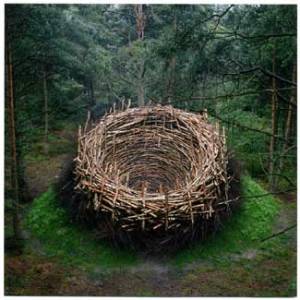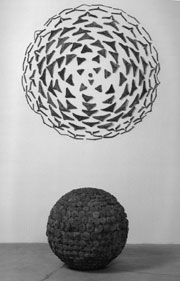Art Therapy and Ecology 4
January 17, 2018
Photos from Top to Bottom: Anya Gallaccio ‘That Open Space Within”, herman de vries ‘Forest Collage’ and David Nash ‘Ash Dome Drawing’
“Movement, change, light, growth and decay are the life-blood of nature, the energies that I try to tap through my work. When I work with a leaf, rock, stick, it is not just material in itself, it is an opening into the processes of life within and around it. When I leave these processes continue.” (Andy Goldsworthy)
Why Art in Nature? The purpose of art making in nature is to experience the natural environment as an outdoor studio and to work with living art materials. It’s an opportunity to explore working with both found natural materials that make marks (i.e. mud, grass, berries, flowers, and charcoal) and to also investigate working with larger sculptural forms that evoke the idea of shelter within forest habitats. Equally, the acts of walking and collecting can be understood as important artistic practices.
Collected objects from nature can be assembled into displays where textures, colours and patterns are highlighted. Since natural materials gradually decompose photography, sketching and writing can be used to document artworks made in the forest. The nature studio offers many experiences to perceive ecology, and to structure these perspectives into a variety of artworks that will explore lines, shapes, dimensions, and patterns found in the natural world. Land Art is an intriguing form of contemporary art which works within a variety of natural environments, transforming living materials into distinct compositions. Nature is unpredictable and constantly changing – these are also the features of environmental art made outdoors within different kinds of habitats.
“I use the world as I find it…A sculpture I’ve made along the way is a sort of celebration of that place, of me being there at that time in that state of mind. It’s a record of that moment in my life.” (Richard Long)
Photos: Andy Goldsworthy, ‘Sticks in River’ (Top) David Nash ‘Ash, Branch, Cube’ (Below)
What is Land Art? Land art is usually made in relation to a specific landscape or location, using collections of natural materials found on site. Land art can be left within the landscape, to be affected by the elements, or it can be transported into a studio space or gallery. This form of art is subject to change, it is ephemeral subject to decay and the impact of ecological processes including the effects of weather. Land Art can also incorporate walking, as a way of drawing upon the landscape. Walking artists consider forest paths to be like lines of drawing, a way of making one’s mark by foot, or taking a line for a walk. Walking artists Richard Long and Hamish Fulton use collections of words to illustrate their journeys through landscapes. Long uses the term textworks to describe the way individual words can encapsulate the essence of nature walks.
Photos from top to bottom: Andy Goldsworthy ‘Rowan Leaves with Hole’, Hamish Fulton ‘Rock, Fall, Echo, Dust”, Chris Drury ‘Shimanto River Sphere’, and Richard Long ‘A Line Made By Walking’
I want an intimate physical connection with the earth. I must touch. I take nothing out with me in the way of tools, glue or rope, preferring to explore the natural bonds and tensions that exist within the earth. The season and weather conditions determine to a large extent what I make. I enjoy relying on the seasons to provide new materials. (Andy Goldsworthy)
What Kinds of Natural Materials can be used for Land Art? Charcoal (collected from abandoned campfires), Berries, Grass, Mud, Seed Heads, Leaves, Moss. Pine Cones, Pine Needles, Roots, Weeds, Flowers, Stones, Logs, Bark and Branches
Photos: A Textwork by Richard Long ‘Day to Day’ (Top) and Patrick Dougherty ‘Childhood Dreams’ (Bottom)
I enjoy the freedom of just using my hands and “found” tools – a sharp stone, the quill of a feather, thorns. I take the opportunities each day offers: if it is snowing, I work with snow, at leaf-fall it will be with leaves; a blown-over tree becomes a source of twigs and branches. I stop at a place or pick up a material because I feel that there is something to be discovered. Here is where I can learn. (Andy Goldsworthy)
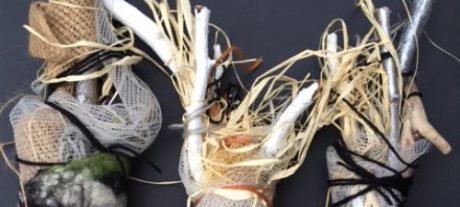
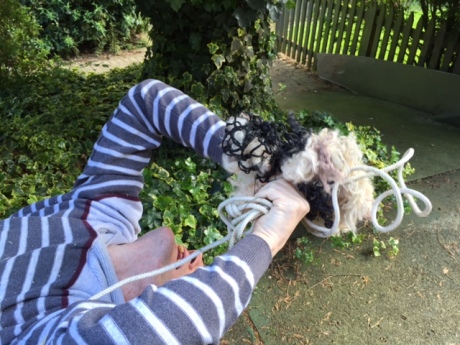
Photos of Art Therapy Bundles, Made from Branches, Felt, Fibre Materials
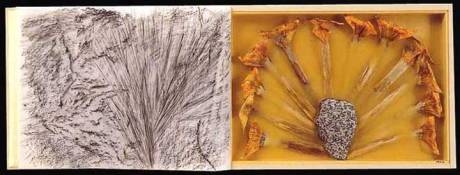
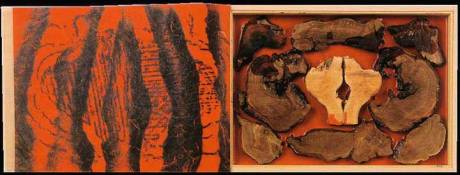
Top Photo: Miguel Angel Blanco, ‘Library of the Forest’, nature collections in wooden “book” boxes that are journals of his walking journeys.
The idea of a book being a collection of objects that are ideas, moments of time, a landscape, and movements held within a box vessel, can be a vital medium of artistic practice within art therapy. A walk can be taken alone or accompanied by others, either can become documented as an art therapy journey that involves the surrounding habitat as living studio. The words of thought and feeling held within the significance of objects selected, illustrate and enact a psychological quest. This is a language of wandering and finding significance in what is close at hand. The book is an installation that can be handled and read in many ways. Time is contained within the dimensions of the book’s architecture. The composition of the book, reveals itself as a structural building, a home place for an ephemeral story.
Websites for Inspiration
- Green Museum The Online Museum of Environmental Art
- Women’s Eco Artist’s Dialog
- Chris Drury
- herman de vries
- Richard Long
- Hamish Fulton
- Patrick Dougherty
- Also Search online for Artist Anya Gallaccio
Materials and Preparation List
Fully charged camera phone or camera for photography
Sketch book or notebook for drawing, for imprints of natural materials, creative writing, and ideas you wish to take away from the workshop
Pencils and pens, graphite, charcoal or pastels for drawing and writing in sketchbook
Tape for attaching foraged items into sketchbook
Containers or bags for foraged items. These materials can be used for artworks after the workshop.
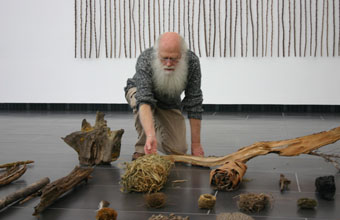
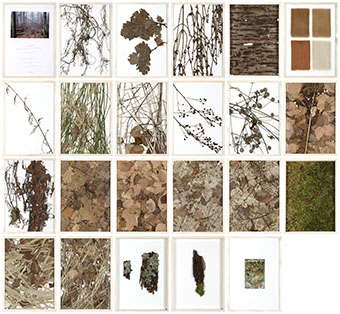
Photos: Collections of nature by artist herman de vries
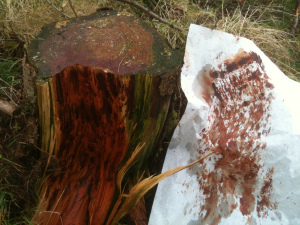
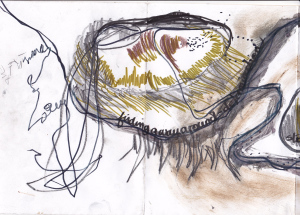
Photo: A print of a tree trunk and a drawing of a forest walk
Photos: Ecole du cloitre Vic sur Seille, Les Photos de Marc Pouyet
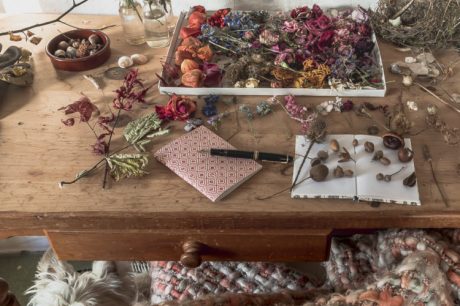
Photo: Kriss MacDonald, “My Botanical Desk – Winter Nature Diary”
Photos: Shelters Made in a Ravensdale Forest, County Louth
Photo: Nils-Udo ‘The Nest’
Photo: Chris Drury ‘Pine Circle, Cone Sphere’
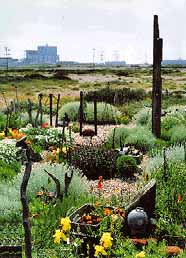
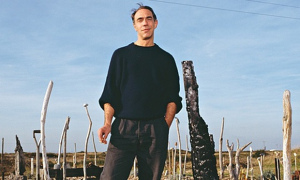
Photo: Derek Jarman photographed by Terry O’Neill (The Guardian)
Derek Jarman (1942-1994) was an English film director, artist, writer, stage designer and gardener. His garden journals, reflections and nature based artworks are profiled in his book Derek Jarman’s Garden. Written before his death the book crusades the proliferation of personality in every garden, rather than codification and regulation. Out of a shore composed of flint and shingle, and near a nuclear power station in Dungeness, Kent, Jarman created a gardening legacy that acts as a stage for not only his own personal experiences, but a catalyst for the pursuits of others who follow his example. An activist opposed to lawns, garden chemicals and the dictation of order, Jarman encouraged a garden’s anarchy and wild abandon. His garden was without borders and conventions, extending in all directions and inwards to meet the realities of landscapes both human and natural. His home, a restored fishing cottage, became his sanctuary and studio for forays into various forms of contemplation and artistic enterprise. The garden is still today infused with the magic of surprise. “I saw it as a therapy and a pharmacopoeia” (Derek Jarman), its essential nature to assist with the experiencing of life cycles.
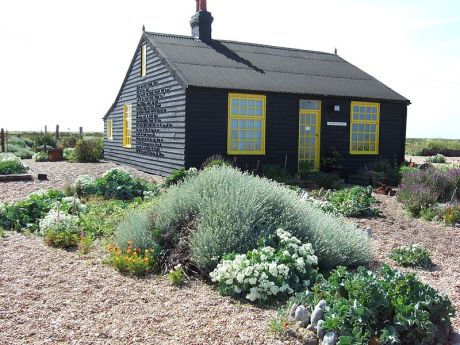
Photo: Derek Jarman’s Garden
“Derek Jarman gave his garden a certain narrative; perhaps he treated it a bit like a film or theatre set. His films were visionary, eccentric, romantic and rebellious, all of which could also be said about his garden. The plants were distinct players in the action…He put wild with cultivated, made art out of rubbish and declared the garden a gallery where nature played the most important part. He sought refuge in his garden, but chose a setting with no boundaries, where everything is an edge: shingle, sea, sun, wind all shifting and changing…It is a weird and wonderful place, but in many ways humble: a small house, a tiny garden, yet the maker showed us all how wild and brilliant our own spaces can be if we’re prepared to look sympathetically at the landscape around us, to make room for the flotsam and weeds in life as much as the jewels.” (Alys Fowler, “Gardens: Planting on the Edge in Derek Jarman’s Garden”, The Guardian, September, 24, 2014
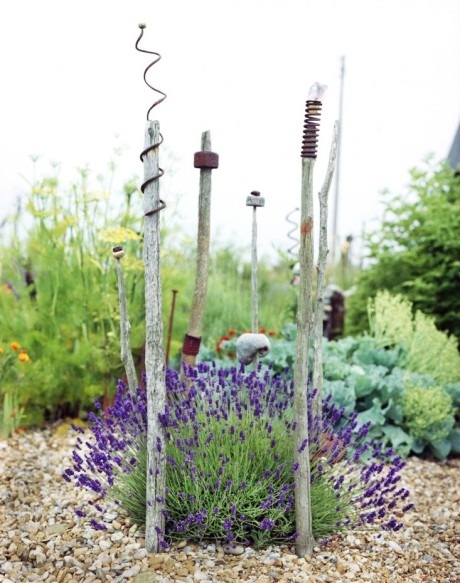
Photo Source: Gardenista
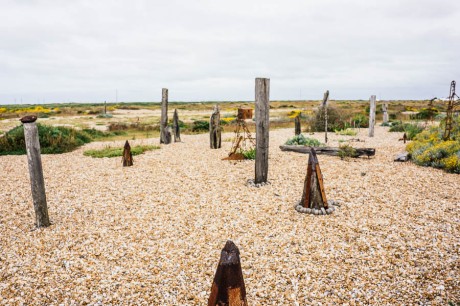
Photo Source: Kriss MacDonald, Derek Jarman’s Garden
